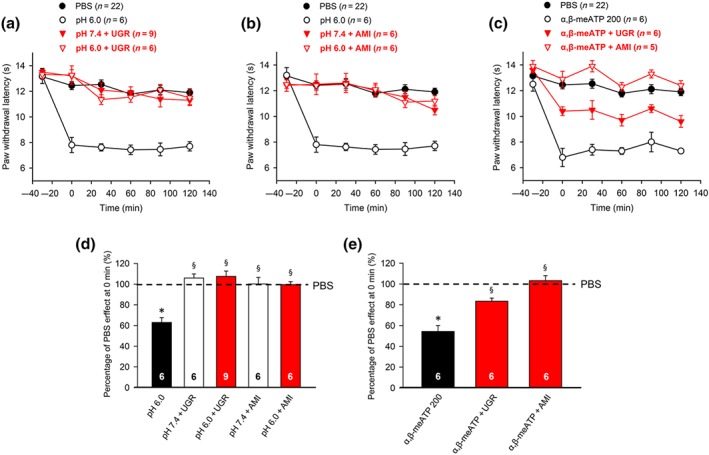Figure 5.

Modulation by selective (Ugr9‐1) or non‐selective (amiloride) ASIC3 antagonists of acute thermal hypersensitivity caused by local acidification to pH 6.0 or injection of α,β‐meATP (200 nM) into the left hind paw of rats at the −30 min time point. PWL measurement was as in Figure 1. Eighty rats as well as seven KO and seven WT mice were used to generate the data presented below. (a,b) The time‐dependent effects of pH 6.0 PBS alone, or together with Ugr9‐1 (20 μM; a) or amiloride (10 μM; b), are shown. For comparison, the change in PWL measured after injection of pH 7.4 PBS was also plotted. (c) The time‐dependent effect of α,β‐meATP (200 nM) alone, or together with Ugr9‐1 (20 μM) or amiloride (10 μM), is shown. Mean ± SEM determined on the bracketed number of animals. Effects of pH 6.0 PBS alone or together with Ugr9‐1 or amiloride expressed as a percentage of the normal PBS (pH 7.4; 100%) effect at 0 min (d). The missing effects of the two antagonistic drugs dissolved in pH 7.4 PBS are also plotted. Mean ± SEM of the indicated number of experiments. Effect of α,β‐meATP (200 nM) alone or together with Ugr9‐1 or amiloride expressed as a percentage of the normal PBS (pH 7.4; 100%) effect at 0 min (d). Mean ± SEM of the indicated number of experiments. AMI, amiloride. * P < .05, significantly different from the mean PWL measured after PBS (pH 7.4) injection at 0 min in b or d respectively. § P < .05, significantly different from the effect of pH 6.0 PBS injection at 0 min in d or e; Kruskal–Wallis one‐way ANOVA on ranks (H = 21.886; d) and (H = 27.726; e), followed by Holm–Sidak test
